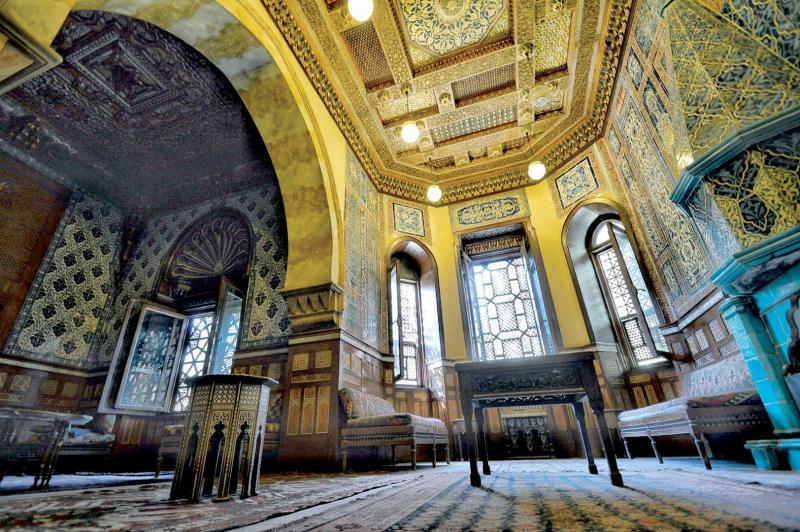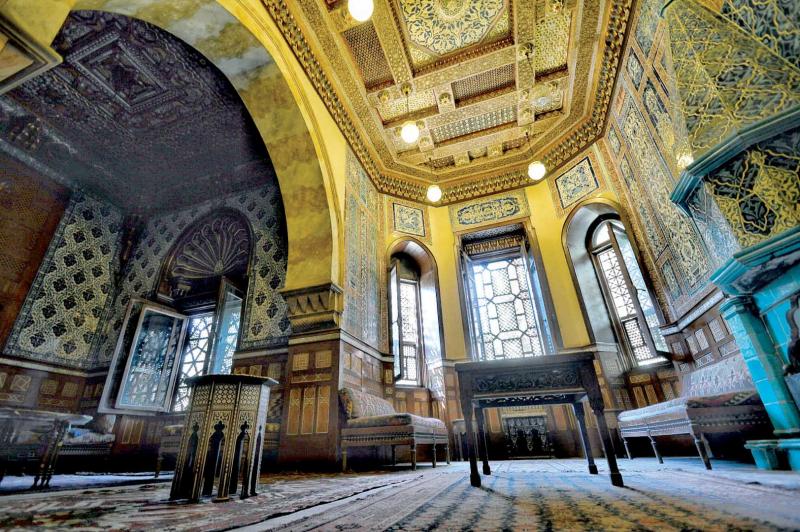Cairo museum offers insight into Egypt’s history under the Mohammad Ali dynasty
CAIRO - The Manial Palace and Museum offers visitors a journey to pre-1952 Egypt when the country was a khedivate, a sultanate and then a monarchy, before the Arab Republic of Egypt and the revolution.
It was an era that was overseen by the Mohammad Ali dynasty. The Manial Palace, perhaps more than anywhere else in Cairo, exemplifies an Egypt that no longer exists.
The museum, constructed on 6.5 hectares in five buildings, including three palaces, is more than just a place where relics of bygone times are exhibited. It is a pulsating centre of dynastic Egypt that was open to foreign influences, especially from Europe, where most members of the royal family were educated.
“The museum contains relics of a very important phase of Egypt’s history, namely the era of the Mohammad Ali dynasty,” said Nader Abdeldayem, a professor of modern Egyptian history at Ain Shams University. “It is a place where members of the royal family lived for many years, which gives it authenticity and lends it greatness.”
The museum, on a Nile River island in southern Cairo, contains many belongings of the Mohammad Ali family and relics of the dynasty.
It reflects the conditions, artistic tastes and cultural influences of the 19th century and the first half of the 20th century when Egypt was under British occupation. The palace is surrounded by Persian gardens, with plants taken to Egypt by the British who had been introduced to them in India.
Almost every part of the museum shows an influence from around the world gathered in Egypt during the numerous travels of the members of the Mohammad Ali family.
One of the rooms of the museum is decorated with wood Mohammad Ali Tewfik who constructed the palace in 1903, obtained from the Azm Palace, an 18th-century Ottoman palace in the west-central Syrian city of Hama.
The Levantine Hall, as it is called, opens onto a smaller room with a floor covered with coloured marble. The smaller room boasts several stained-glass windows, and light entering the room is reflected into a harmonious invasion of colours.
Another room boasts a Moroccan style with most of its contents, decorations and tastes taken to Cairo from Morocco.
The ceiling of the room is made of reflective glass protruded by wooden shapes that look like stars in the sky. There are two handmade tables in the middle of the room that were used for serving food and drinks. The amount of work into making them manifests itself in the perfect nature of the drawings engraved into them. There are also wooden arabesque sofas that demonstrate deep Moroccan influences with their embroidered pillows.
The museum contains the personal belongings of the Mohammad Ali family. One of the rooms is a copy of Tewfik’s mother’s room in France. The emir’s mother did not want to go to Egypt so he made an identical copy of her bedroom in France to convince her to live with him in the palace.
Mohammad Ali Tewfik mixed European, Islamic, Ottoman, Moroccan and Persian influences in building the palace. It contains a much of his personal and his family members’ art collection, mediaeval manuscripts and his clothing.
“Behind every piece of furniture, every item and every corner, there is an extensive story of one of the members of the family that ruled Egypt for so long,” said museum Director Walaa Badawi. “This is a place so rich that visitors might find the duration of one visit far from enough to fathom the things they see before their eyes.”
This palace-turned-museum, which was built in 1903, witnessed the birth and death of Mohammad Ali Tewfik’s dream of ruling Egypt.
He was a son of Khedive Tewfik I, the sixth ruler of Egypt of the Mohammad Ali Pasha dynasty, who ruled the country from 1879-92. Mohammad Ali Tewfik had prepared himself to rule Egypt for many years. When he built the palace, he even specified one of the rooms for the throne.
The oldest emir of the Mohammad Ali family, Tewfik’s dream of ruling the country was dashed when King Fuad’s son, Farouk, was born. Until then, he had been the presumptive heir. When King Fuad died in 1936, Mohammad Ali Tewfik served as regent for the 16-year-old crown prince until he ascended to the throne in July 1937.
King Farouk did not have male children to succeed him, which kindled Tewfik’s dream of ruling Egypt once more.
However, in January 1952, Farouk’s wife, Nariman, gave birth to a boy. This ended Tewfik’s dream of ruling Egypt. However, it was not just Mohammad Ali Tewfik’s dreams of ruling Egypt that were soon dashed but the Mohammad Ali dynasty’s. Six months after the birth of Crown Prince Ahmed Fuad, the monarchy was overthrown by army officers who declared the modern republic.
Many of those visiting the palace are not aware of Egypt’s complex dynastic history. The Egypt that is in evidence in the luxurious rooms and halls of the Manial Palace is akin to a foreign country.
The museum attracts students studying pre-1952 revolution Egypt and foreign tourists. For tourists, a visit to the palace can include other southern Cairo sights, including the Saladin Citadel and the ancient Islamic prayer houses nearby.
University student Mohamed Hassan, visiting with a group of friends, strolled through the palace’s halls before closing time. He had previously visited the museum as a child with his father but he said that he had a better appreciation of Egypt’s complex history on his second visit.
“I come this time while I am more aware of the historical events that made the lives of the people who lived in this palace,” Hassan said. “This is a proud part of the history of Egypt that demonstrates the high tastes of Egypt’s rulers of the time.”
Hassan Abdel Zaher is a Cairo-based contributor to The Arab Weekly.
This article was originally published in The Arab Weekly.




